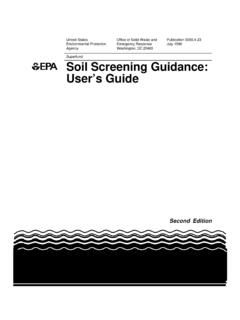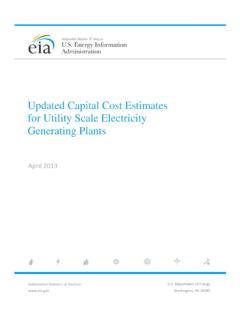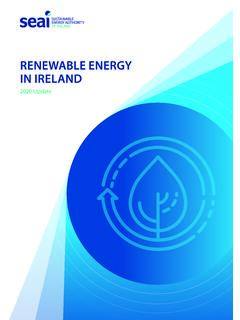Transcription of P50/P90 Analysis forSolar Energy Systems Using the System ...
1 P50/P90 Analysis for Solar Energy Systems Using the System Advisor Model Preprint A. Dobos and P. Gilman national Renewable Energy Laboratory M. Kasberg Pariveda Solutions Presented at the 2012 World Renewable Energy Forum Denver, Colorado May 13-17, 2012 NREL is a national laboratory of the Department of Energy , Office of Energy Efficiency & Renewable Energy , operated by the Alliance for Sustainable Energy , LLC. Conference Paper NREL/CP-6A20-54488 June 2012 Contract No. DE-AC36-08GO28308 NOTICE The submitted manuscript has been offered by an employee of the Alliance for Sustainable Energy , LLC (Alliance), a contractor of the US Government under Contract No.
2 DE-AC36-08GO28308. Accordingly, the US Government and Alliance retain a nonexclusive royalty-free license to publish or reproduce the published form of this contribution, or allow others to do so, for US Government purposes. This report was prepared as an account of work sponsored by an agency of the United States government. Neither the United States government nor any agency thereof, nor any of their employees, makes any warranty, express or implied, or assumes any legal liability or responsibility for the accuracy, completeness, or usefulness of any information, apparatus, product, or process disclosed, or represents that its use would not infringe privately owned rights.
3 Reference herein to any specific commercial product, process, or service by trade name, trademark, manufacturer, or otherwise does not necessarily constitute or imply its endorsement, recommendation, or favoring by the United States government or any agency thereof. The views and opinions of authors expressed herein do not necessarily state or reflect those of the United States government or any agency thereof. Available electronically at Available for a processing fee to Department of Energy and its contractors, in paper, from: Department of Energy Office of Scientific and Technical Information Box 62 Oak Ridge, TN 37831-0062 phone: fax: email: Available for sale to the public, in paper, from: Department of Commerce national Technical Information Service 5285 Port Royal Road Springfield, VA 22161 phone: fax: email: online ordering: Cover Photos: (left to right) PIX 16416, PIX 17423, PIX 16560, PIX 17613, PIX 17436, PIX 17721 Printed on paper containing at least 50% wastepaper, including 10% post consumer waste.
4 1 WREF 2012: P50/P90 Analysis FOR SOLAR Energy Systems Using THE System ADVISOR MODEL Aron P. Dobos Michael Kasberg Strategic Energy Analysis Center IT Consultant national Renewable Energy Laboratory Pariveda Solutions Phone: Denver, CO Email: Paul Gilman Technical Consultant to the national Renewable Energy Laboratory Portland, OR To secure competitive financing for a solar Energy gen eration project, the economic risk associated with inter-annual solar resource variability must be quantified. One way to quantify this risk is to calculate exceedance probabil ities representing the amount of Energy expected to be pro duced by a plant.
5 Many years of solar radiation and metere ological data are required to determine these values, often called P50 or P90 values for the level of certainty they repre sent. This paper describes the two methods implemented in the national Renewable Energy Laboratory s System Advi sor Model (SAM) to calculate P50 and P90 exceedance prob abilities for solar Energy projects. The methodology and sup porting data sets are applicable to photovoltaic, solar water heating, and concentrating solar power (CSP) Systems . Introduction The economic value of a solar Energy generating facility depends on the availability of the solar resource. The so lar radiation, and to a lesser extent, temperature, humidity, atmospheric pressure, and wind speed determine the timing and quantity of Energy the facility generates.
6 Weather-related events such as passing clouds or storms introduce resource variability at short time scales, and larger-scale events such as volcanic eruptions and climate cycles introduce variabil ity on larger, inter-annual time scales. In their assessment of the value of a solar Energy project, financial institutions use statistical methods to determine the likelihood that a power plant will generate a certain amount of Energy in any given year over the plant s 20- to 30-year life. Exceedance probabilities have been widely used in the wind industry to describe the probability that a particular lo cation will experience sufficient wind speeds for a proposed wind farm to be financially sound.
7 Banks and investment firms working on wind farm projects often require P50 and P90 values of the wind resource at a location to determine the risk associated with a project s ability to service its debt obligations and other operating costs. Although the solar re source is generally more predictable than wind [7], the ex ceedance probability risk assessment approach can also be applied to solar Energy projects. Statistically robust estimates of Energy generation ex ceedance probabilities require many years of resource data, as well as sufficiently detailed System performance models. The System Advisor Model (SAM) is a free software appli cation produced by the national Renewable Energy Labora tory that performs rigorous solar power plant System perfor mance modeling and calculates detailed financial cashflows.
8 SAM calculates metrics such as annual Energy output, capac ity factor, levelized cost of electricity (LCOE), internal rate of return (IRR), and others for flat-plate and concentrating photovoltaic generators, as well as various configurations of concentrating solar power (CSP) Systems including parabolic trough, power tower, dish stirling, and linear Fresnel, with and without thermal Energy storage (as applicable). This paper describes SAM s P50/P90 Analysis capabil ity, starting with the available long-term weather datasets, details of the calculation methods for P50 and P90, and ex plores two representative Analysis scenarios for a utility scale flat-plate PV System and a solar power tower System .
9 2 Solar Radiation and Weather Data Some solar Energy simulation software use files from the Typical Metereological Year (TMY) datasets [1, 2] as input. TMY files are available for many locations in the United States, making them suitable for use in simulation models 13 like SAM. The TMY2 and TMY3 datasets consist of a file for each location, and each file contains hourly data derived from long term measured data. The data are processed by choos ing typical months to represent the long term properties of the data. Data representing months during outlier events such as large volcanic eruptions are excluded to ensure that the file represents the long-term climate.
10 For project financial anal ysis, these outlier events may result in worst-case years that affect the project s financial terms. Because the TMY files do not include data from these potential worst-case years, they may be more appropriate for preliminary Analysis of a System design than for financial decisions. Using multi-year histori cal data to model the long term performance of a System in stead of a TMY file ensures that the performance prediction accounts for potential worst case years [6]. The national Solar Radiation Database (NSRDB) is a long term hourly dataset of measured and modeled solar ra diation for hundreds of locations in the United States.















